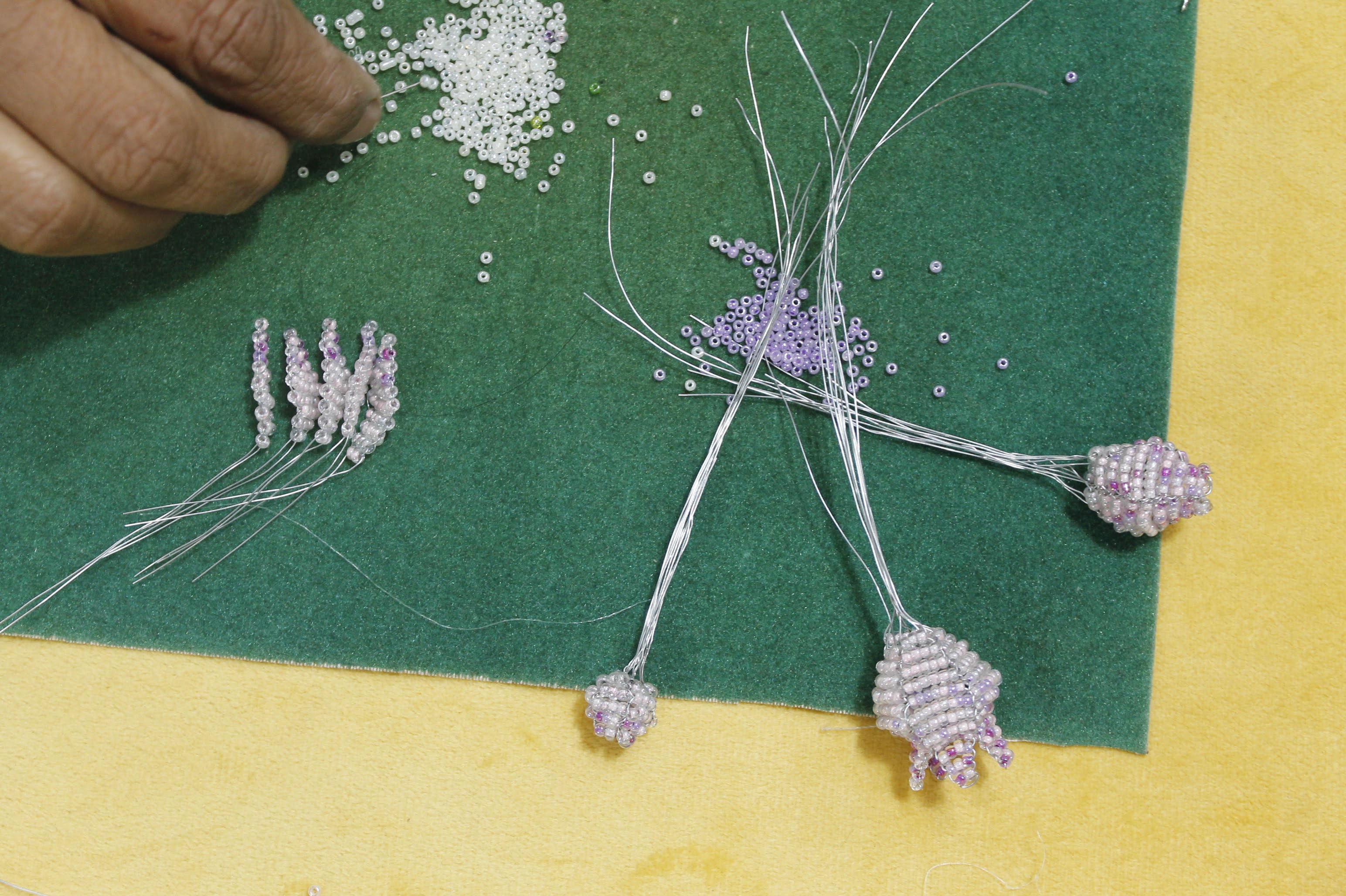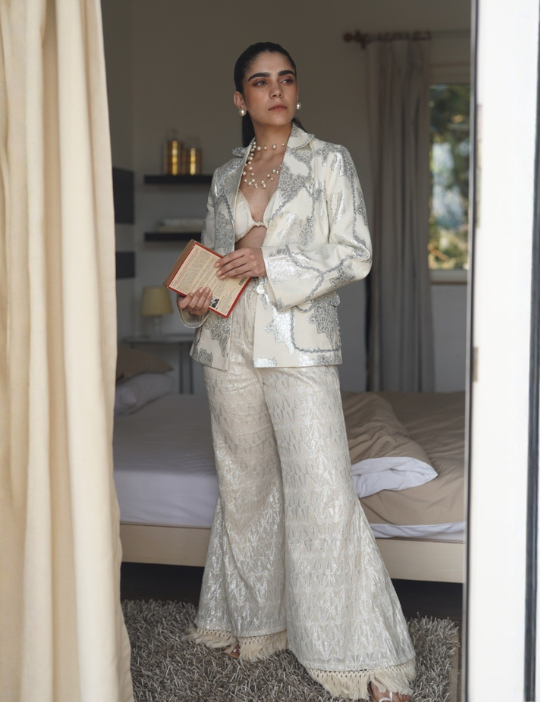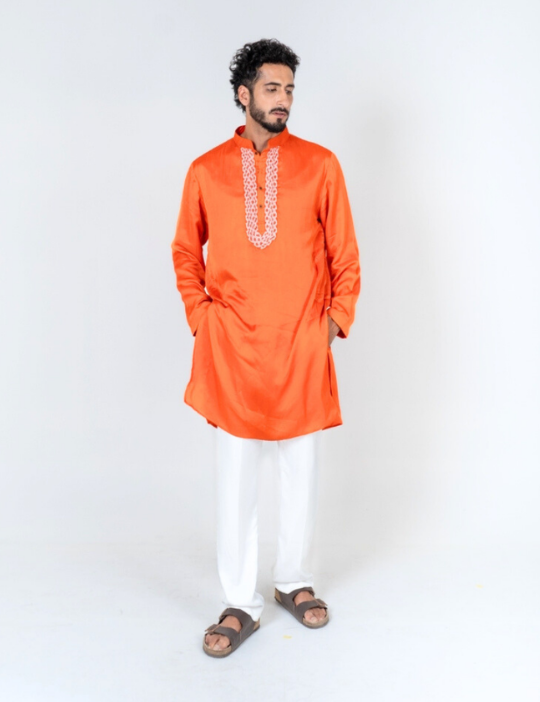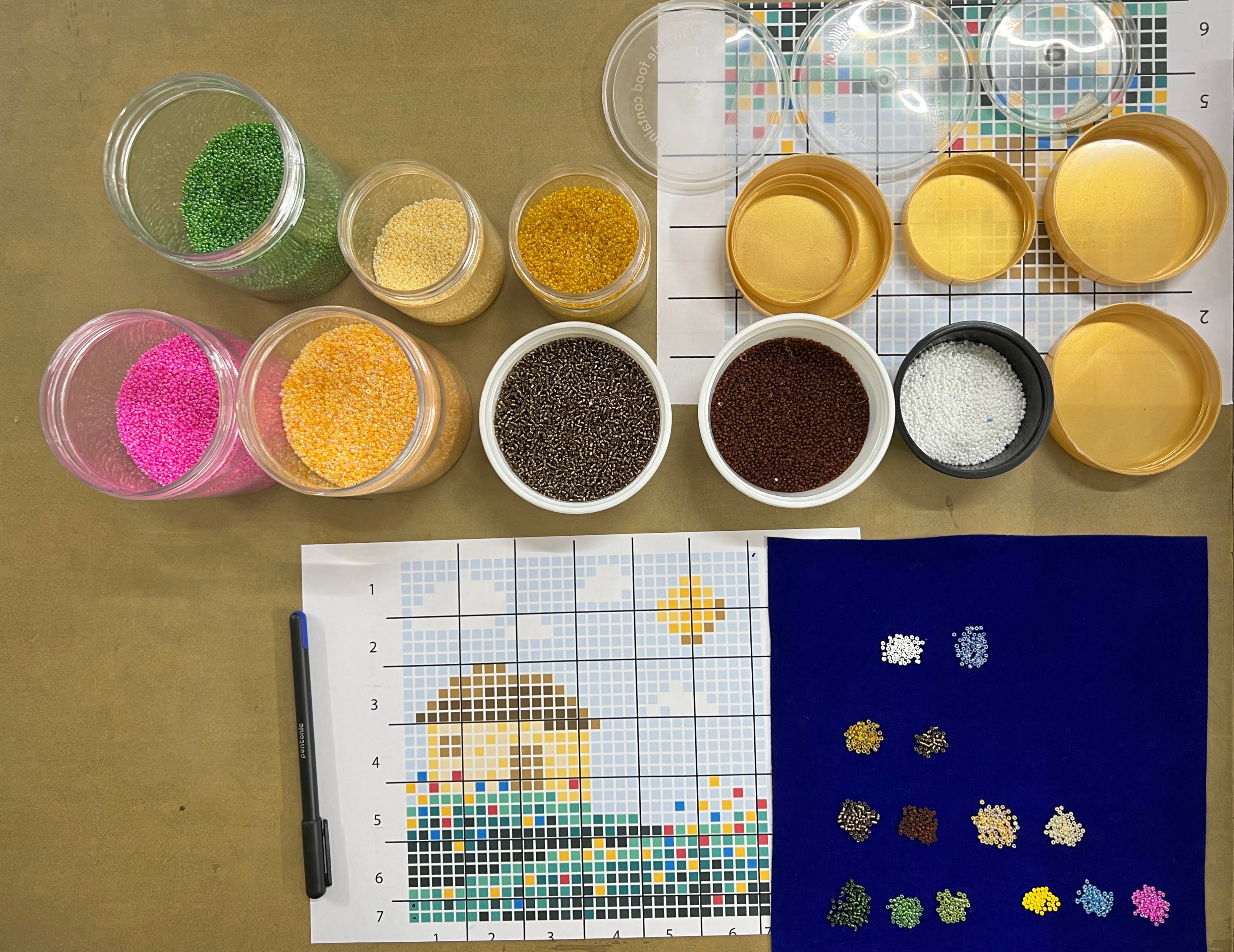About the Brand
What is the name of your brand and what does it stand for?
Rata means pleased, delighted, or fondly attached in Sanskrit — exactly how we feel about what we do. The name also weaves together the letters of my first and last name, just as we string beads into something whole and intentional. The ‘love’ in our name is not decoration — it’s our foundation and quiet fuel. Every piece is an act of care — crafted not just with hands, but with heart.
When was it founded, and what inspired its beginning?
With beginnings as humble as the basement of a quaint little building in the bustling city of Gurugram, India, Studio RATA, started by Pratiksha Tandon in 2023, is a luxury lifestyle brand that provides a curation of whimsical beaded art jewellery and lifestyle accessories.
In 2021, I left my job without a plan, only a need to pause and find something more alive, more personal. I spent months caring for my parents through cancer treatment — days that slowed me down and brought me closer to my own hands. In that stillness, beadwork found me again, thread by thread, like a soft reminder that beauty can grow slowly, even in hard seasons.
There was no big roadmap — just an urge to create a space that felt safe, open, and kind. Not a workplace, but a gentle sanctuary where craft, emotion, and identity could breathe. From the start, Rata was never about mass-making or following trends — it was about shaping small, intricate pieces that feel like poetry — intimate, patient, and alive with quiet stories. The magic of Rata lives in the tiny choices: to sit on the floor with beads scattered like seeds; to spend hours on a single petal; to value one-of-a-kind over one-size-fits-all.
What makes your brand uniquely Indian?
Rata’s soul is Indian — not because of motifs or ornament, but because of how we work. We sit close to the ground, we move slowly, we learn by doing — by failing, trying, and trusting our hands. Our process is layered and intuitive, echoing India’s quiet craft legacies.
Our sculptural beadwork draws from humble bead traditions like Moti Bharat and tribal motifs — once simple, domestic, often overlooked. We honour that quiet history but shape it into contemporary, blooming forms. There’s restraint, softness, and poetry in our details — a side of Indian design that whispers instead of shouts.
About the Founders
Who is the founder? Please share a short personal introduction. What inspired you to start this brand?
I am Pratiksha Tandon, the founder of Rata. I was born in 1994 in Indore, and for as long as I can remember, I have been drawn to the quiet details. The way light moves across a surface, the rhythm of textures, the emotion a certain colour can hold, the feeling something handmade can evoke without ever needing to speak. That sensitivity led me to study fashion design at NIFT Gandhinagar, where I began to shape my understanding of material, form, and storytelling.
After graduating in 2016, I began my career with internships at Gokaldas Exports and with Rahul Mishra, before moving on to work with craft-led brands like Péro and Eká. Those years were foundational. They gave me an intimate understanding of slow design, the value of handcraft, and the beauty that lies in restraint. I learned not only how to design clothing, but how to honour the process, the artisan, and the idea that every thread and stitch can carry memory.
But it was only when I stepped away from the structure of the fashion industry that I began to reconnect with myself as a maker. In 2018, I took a break to care for both my parents, who were undergoing cancer treatment. That period of stillness shifted something within me. It became a time of reflection, of slowing down, and of returning to what felt emotionally honest and creatively grounding.

It was during those quiet, uncertain days that I began weaving again. I began learning through books, online videos, and anything I could get my hands on, not with any agenda or outcome in mind, but simply to make. Slowly, bead by bead, I began to rediscover a sense of joy and presence. What started as a personal act, an attempt to hold on to beauty in a difficult time began to grow into something more.
Rata was not a planned brand or a business idea on paper. It came into my life gently, during a time when everything else had paused. It unfolded slowly, shaped by emotion, memory, and care. For me, Rata is more than a label. It is my most personal work, a space where my beliefs, my love for nature, and my reverence for slow, handcrafted processes come together. It was built through instinct, repetition, failures, and small discoveries. Over time, beading became more than a technique. It became a language.
Do you have any personal connection to the craft, textile, or region your brand represents?
Yes — deeply and personally. My connection to beadwork wasn’t taught in a classroom; it came to me like a quiet inheritance I didn’t know I had. Unlike frame embroidery, our craft is built bead by bead, held up by nothing but tension, patience, and trust in the maker’s hands. It’s a skill I taught myself in still, slow moments, sitting on the floor with no plan — only the need to feel connected to something gentle.
This kind of beadwork is rooted in the small folk traditions I grew up around — the torans, the tiny tribal bead trims my grandmother once wore. It’s unglamorous work in many eyes — too humble to be heroed — but to me, it’s magic. A single bead can hold memory, care, and hours of silent touch.
The Team & People Behind the Brand
Can you tell us about the team behind your label? Do you work with local artisans, karigars, or craft communities?
We are not a large organisation, but every person here plays an essential role in bringing the work to life. Our design and production process is very hands-on. I personally lead the design direction, from the initial sketches to prototyping, and I continue to stay closely involved in the making of every piece.
The artisans/beaders we work with have been trained in-house from scratch. Many of them came to us without prior experience in beadwork. We spent months just teaching, practising, and slowly building skills and trust. Some of them stayed, and some moved on, but the ones who stayed became a core part of Rata’s voice. Today, some of our artisans are confident enough to experiment and bring their own creative suggestions, which I value deeply. We work side by side, and the process is collaborative, fluid, and full of learning.

Are there any people or partnerships you’d like to credit or highlight?
Rata was never meant to be built alone — and it never truly was. While the seed was planted in my own hands, its roots have always spread into the lives and care of others.
At the heart of Rata is our small, patient team of beaders and artisans — many of whom came to us as beginners, learning this craft from scratch. They stayed, grew, and now shape every petal, every curve, every bloom with a quiet mastery that only time can teach. Their hands carry our stories forward, bead by bead.
Beyond our studio, I hold deep gratitude for the artists, brands, and unexpected champions who saw our work for what it is — soft, intricate, honest — and invited it into new spaces. Collaborations with brands like VegNonVeg challenged us to push the form — a fully hand-beaded sneaker is not something we could have dreamt alone. Artists like Dhee, Osho Jain, and Tanmaya Bhatnagar brought our craft into music, poetry, and visuals, blurring lines between object and story. Sometimes the most powerful partnerships happen quietly — a stylist choosing our work for a red carpet moment, a muse wearing a piece that carries our tiny world onto a global stage.
Craftsmanship & Textiles
What kinds of textiles, weaving, dyeing, or embroidery techniques does your brand use?
Our approach is more raw, exposed, and complex. We begin from nothing. No base, no fabric, no surface to rest upon. Every piece starts with a single bead, and from that point we build. One bead becomes two, two grow into a line, and that line begins to bend, fold, and layer, eventually forming a petal, a leaf, and a stem. Each element is shaped in space, suspended and structured entirely through tension, direction, and the memory of the thread. There is no surface to hide behind, no space to cover up mistakes. Every movement is visible, every decision felt. What we are doing is more akin to freeform sculpting, where the form evolves organically in the hands of the maker. Combining this form of bead weaving with other materials like wire or crocheting allows us to push the boundaries even further. The techniques begin to speak to one another. Wire brings structure, beads bring the body, and thread brings movement. And together, they let us build objects that feel like they are still growing, still becoming.

Is there a story behind the craft you work with?
Yes, there is. Bead weaving, though not widely recognised in mainstream Indian craft narratives, has quietly existed across regions like Gujarat, Madhya Pradesh, and parts of South India. In these clusters, the technique was often practised by women in domestic spaces, used to create torans for doorways, mats, decorative items for idols, and simple, flat jewellery strung together with basic patterns. At Rata, while we don’t follow traditional methods in their exact form, our practice is deeply connected to this lineage. What was once flat and decorative, we reinterpret as sculptural and expressive. We build every piece in an open space, without cloth, mesh, or frames, shaping petal by petal, from a single bead outward.
How are the materials sourced?
Most of the beads we work with are glass, carefully sourced from trusted vendors who specialise in high-quality imports from the Czech Republic and Japan. We also work with a few Indian manufacturers whose factory-made beads meet our quality standards. Every time we restock our beads, they go through a series of checks to ensure the colours don’t bleed and are truly permanent.
We’ve already connected with local bead makers from Purdilnagar, a town known globally for its traditional glass-blown decorative beads. While we’ve sourced some beautiful pieces from there, we’ve also observed a gap; limited resources and a hesitation to experiment with newer designs have made it challenging to push the creative envelope just yet.
How do sustainability, slow fashion, or ethical practices show up in your brand & how do you approach production?
At Rata, sustainability starts with respecting the hands that make it. We don’t believe in rushing the process or pushing unrealistic timelines, carefully established in collaboration with our artisans to ensure it’s comfortable and fair.
We consciously avoid overproduction by advocating and promoting a made-to-order and custom-order model, allowing customers to get complete value for money for what they are purchasing. By slowing down, we reduce excess waste, avoid stockpiles of unsold goods, and work with intention, producing only what’s needed, when it’s needed.
This slower, more intentional rhythm isn’t just better for our artisans, it’s gentler on the planet too. Less waste, fewer resources stretched thin, and more value placed on every single piece. It’s a balanced approach, thoughtful for the maker, respectful of the buyer, and mindful of the world we’re all a part of.
We are dedicated to sustainability and committed to minimising waste. Unlike traditional artificial jewellery that is often discarded after use, we encourage our customers to recycle, reuse, and revamp their pieces. If a customer grows tired of a specific piece, we provide the opportunity to transform it into a new item of their choice at an affordable price. This service requires little to no new materials, as the materials from the original piece can be easily repurposed.
Design & Aesthetic
How would you describe your design philosophy or signature style?
At its core, my design philosophy is guided by emotion, intention, and the quiet power of craft. I don’t believe in designing for trends. I design to tell a story, one that often begins in silence, in stillness, in observation. Whether it’s the curve of a petal, the movement of light through leaves, or the fragility of memory, I try to translate those fleeting details into something tangible.
Rata’s signature style is whimsical, poetic, and sculptural. It invites curiosity. We work with beads not just as embellishments, but as building blocks to form three-dimensional shapes that bloom and breathe. Our work blurs the line between jewellery and art, sometimes wearable, sometimes collectable, and always emotionally resonant.
How do you blend tradition with contemporary fashion?
Bead weaving, the heart of what we do at Rata, has existed in quiet corners of India for generations. It’s often been used in simple forms: flat torans for homes, delicate mats, or ornamental jewellery. But what excited me was the possibility of giving this quiet, often overlooked craft a new visual language that feels current yet rooted. Our pieces might draw from old techniques, but their shapes, colours, and concepts are guided by personal memories, emotional nuance, and artistic exploration.
Who is the muse or ideal wearer of your designs?
The muse for Rata isn’t defined by age, gender, or background; it’s a spirit, a feeling. Our ideal wearer is someone who feels deeply, someone who values intention over impulse. They’re drawn to things that tell a story, that hold a quiet kind of magic. They don’t wear jewellery just to accessorise, they wear it to express, to connect, to remember.
Your India
What does Made in India or Born in India mean to you personally?
“Made in India” to me feels like coming home.
It’s the smell of summer afternoons spent threading beads in a quiet corner, the sound of artisans laughing in between long hours of weaving, the warmth of something shaped slowly by hand, not in a factory but in a space filled with intention. It reminds me of the women I grew up seeing, creating beauty with whatever little they had, making, mending, embellishing with care, never for applause, just because it brought them joy.
Being born in India means I’ve grown up surrounded by craft that speaks without words. It’s in the colours of a local bazaar, the rhythm of folk songs, the rawness of hands that work without complaint. There’s something in the pace of it all, never hurried, never loud, but always full of life. That’s the heartbeat I wanted to carry forward with Rata. For me, “Made in India” is not a marketing tag, it’s a promise. A promise to honour the beauty that’s already here. To believe that the most extraordinary things can come from the most humble places. And to trust that if we create with honesty, the world will listen.
Looking Ahead
What is your vision for the future of your brand?
I see Rata growing deeper into what we already love doing, creating even more intricate, detailed work and expanding our range beyond jewelry. We’d love to explore new design spaces like home, playful objects, clothing, and interiors; basically finding new ways to let this craft live and breathe in everyday life.
One of our biggest dreams is to turn Rata into a collaborative space; a platform where other creatives can come together and co-create something truly magical. Whether it’s through art, design, or storytelling, we want to keep building a community that values craft, care, and creativity.
And of course, we’d love to grow our online and retail presence, have Rata stocked in major stores across India and eventually overseas as well. We're definitely aiming to expand our presence abroad, because we’ve felt that the true value and appreciation for our craft often resonates more deeply outside of India. There’s a certain curiosity and respect for slow-made, handcrafted work that really aligns with what we do at Rata. It’s not just about growing our audience, it’s about finding people who genuinely see the work, who connect with the intention and detail behind each piece. That kind of appreciation fuels us to keep going and keep creating. But through it all, the goal is to stay true to our roots and keep evolving with intention.



.png?v=1764095337)

.png?v=1764095337)











